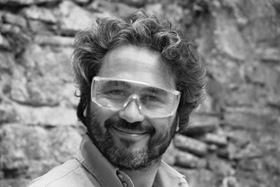und Leonida De Filippi
Works of the MART, Museo di Arte Moderna
e Contemporanea di Trento e Rovereto,
Fondazione VAF
25.07.–14.10.2012


|
Intro Views of the exhibition
Over the course of the twentieth century, the term historical painting underwent a substantial extension. Counting among historical paintings are such works in which artists critically examine socially relevant or political themes as well as current events, among others, those of war, protest movements, terrorism, revolution, social upheaval etc. Firstly, so as to evince military conflict and volatile social events artists began drawing more heavily on means of expression used in abstract painting. Secondly, and above all since the 1960s, it was the processing of the medially communicated picture of history and the response to the image of historical events in the electronic mass-media that was to constitute the focal point of artistic investigation. Among others, it was artists of the likes of Hans Richter, George Grosz, Pablo Picasso, K.R.H. Sonderborg, Anselm Kiefer, Mark Lombardi, On Kawara, Hanne Darboven or Gerhard Richter who were to shape the development of historical painting and who were to create various formal pictorial structures during the twentieth century. Similarly, the point of departure for Leonida De Filippi’s paintings (*1969, Milan) is international socio-political events. Since the 1990s, his works testify to the artist’s endeavor to assimilate and come to terms with war scenes in Iraq, Afghanistan and, more recently, the events of the Arab Spring, for which he has recourse to media sources. As already suggested by the title of his works, in History those events are subjected to pictorial analysis that are destined to at some point become part of history. Keep Shooting is a sobering narrative on the war that infiltrates our lives through the media. Combat scenes, helicopters, soldiers executing orders are to be seen in his pictures. At a first glance, Leonida De Filippi’s works appear like photographs and initially prompt visual irritation within the viewer. Indeed, this involves images in the classical medium of painting. De Filippi begins by enlarging his pictorial template with the aid of reproduction techniques such that he receives a very course resolution of the picture either in pixels, dot matrix or horizontal lines, which he then transfers to his paintings. Half-tones are excluded already at this stage of the process where a stronger contrast, graphic precision and visual tension is achieved. Through this process, semi-abstract pictures begin to emerge. At the same time, De Filippi exposes missing pixels and lines and thus points to the picture’s blank spaces – to a loss of information, which is already present in the pictorial template, but that would otherwise go unnoticed. By transferring photographs or television images to painting, and thereby, as a rule, making visible concealed medial traces, De Filippi facilitates reflection on these media which, in spite of the knowledge of their manipulability, never lost their documentary character and their validity. By crossing two medias, the artist presents for discussion the genres of photography and painting which continue to be considered authentic and, in doing so, also the real as such. The pictures thus generate a surreal impression of the blending of the real and the virtual. We encounter the same indistinguishability between the real and the virtual in contemporary war reporting. “Simulated non-war”, as carried out on the “strategic stage of television”, was how Jean Baudrillard characterized the first Gulf war as early as 1991, and prior to any acts of war. The “postmodern” is primarily concerned with the struggle for the best media images. In the process, the victims are withdrawn from the visual field. In the media spectacle, which is generated through the flood of images and information, the reality of war is no longer illustrated, but staged is success – much like Hollywood films – by way of special effects. The push-button, remote controlled war transports the belligerents into a video game situation, whereby the distinction between real and virtual worlds ceases to exist. As predicted by Paul Virilio in his essay War and Cinema. The Logistics of Perception as early as 1984 [1] for modern war, the virtual live image has thus become indispensable, for example, for reconnaissance purposes and the GPS guidance of smart bombs and drones. Hence, the transition to the digital and virtual image also goes hand-in-hand with an anxiety about a loss of control over computer-aided perception. In the video installation “Vampa,” by Stefano Cagol (*1969, Trient), we encounter the same sense of irritation. The artist takes the North American flag as the basis of his work. Hardly any other national symbol in the Western World is as ubiquitous and linked to such different meanings. For the one, the flag continues to represent the American dream of freedom, democracy and the struggle against fundamentalist terror, while for the other it signifies the acts of belligerence and capitalist imperialism over recent decades. In his video, Cagol mirrors the virtually manipulated image of the waving flag, which thus assumes ever new iconic, occasionally anthropomorphic forms. Associations with vampires, masks, flowers, bats, emblems, and fighter jets are evoked. Here, as in the Rorschach test, imagination and mind-games take the place of the unswerving belief in state symbology. Cagol thus demonstrates the way in which, in a different context, a symbol of freedom may otherwise stand for violence and war. He also pursues this ambiguity of signs in the play on the word Vampa, which means flame and is reminiscent of vampire, and vamp, which alludes to the transformation of signs and images. It is no mere coincidence that the title one of the first versions of the video is “Lies.” Here, one may recall Jean Baudrillard’s suggestion: “One must resist the probability of all images, of all information. Become more virtual than the event itself; do not attempt to restore the truth – we do not have the means of this; but do not allow oneself to be deceived.”[2]Curators: Idis Hartmann, Daria Mille [1] Paul Virilio, War and Cinema. The Logistics of Perception, London, 1989. [2] Jean Baudrillard am 29.03.1991, in: Les cibles de Baudrillard dans «Liberation», in: http://www.liberation.fr/evenement/010195957-les-cibles-de-baudrillard-dans-liberation (Abfrage vom 12.07.2012) |

